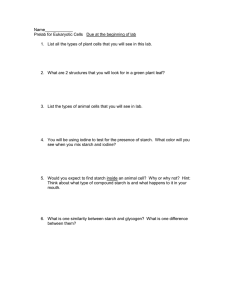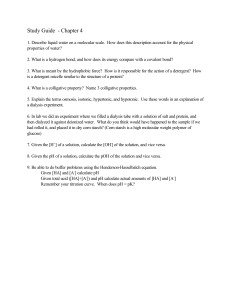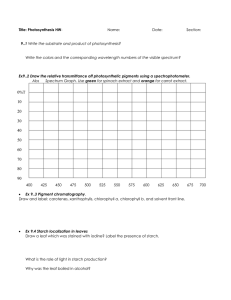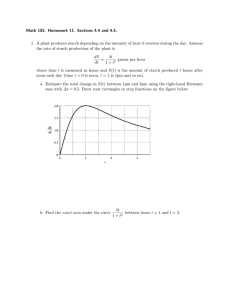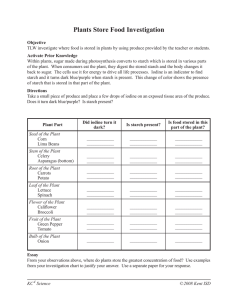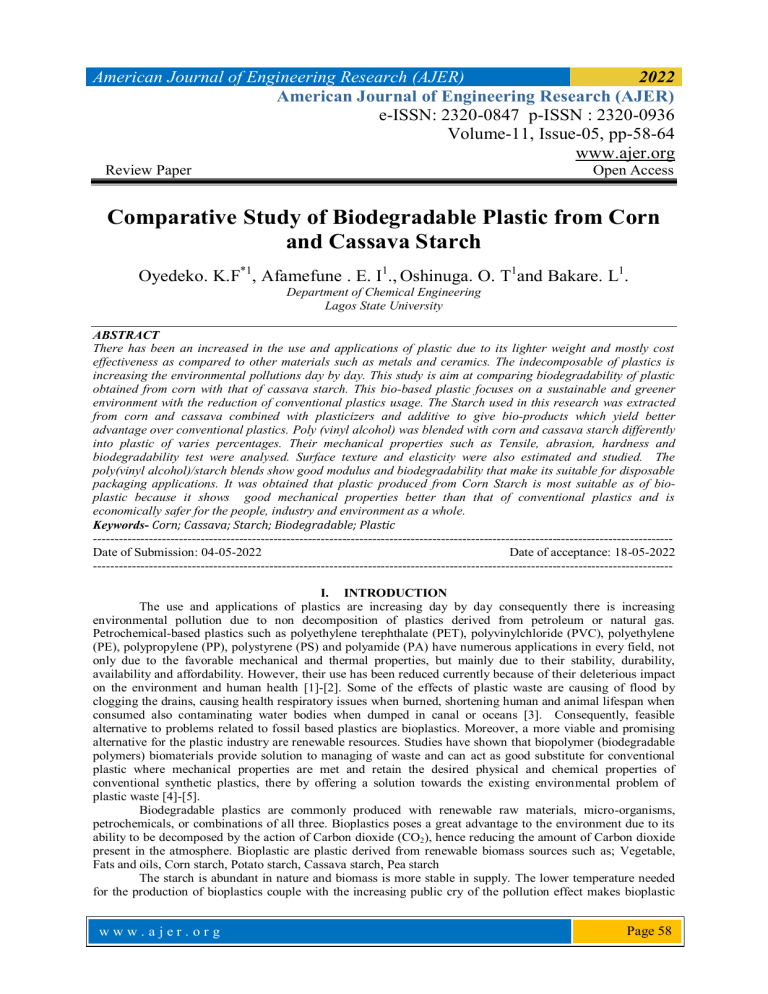
American Journal of Engineering Research (AJER)
2022
American Journal of Engineering Research (AJER)
e-ISSN: 2320-0847 p-ISSN : 2320-0936
Volume-11, Issue-05, pp-58-64
www.ajer.org
Review Paper
Open Access
Comparative Study of Biodegradable Plastic from Corn
and Cassava Starch
Oyedeko. K.F*1, Afamefune . E. I1., Oshinuga. O. T1and Bakare. L1.
Department of Chemical Engineering
Lagos State University
ABSTRACT
There has been an increased in the use and applications of plastic due to its lighter weight and mostly cost
effectiveness as compared to other materials such as metals and ceramics. The indecomposable of plastics is
increasing the environmental pollutions day by day. This study is aim at comparing biodegradability of plastic
obtained from corn with that of cassava starch. This bio-based plastic focuses on a sustainable and greener
environment with the reduction of conventional plastics usage. The Starch used in this research was extracted
from corn and cassava combined with plasticizers and additive to give bio-products which yield better
advantage over conventional plastics. Poly (vinyl alcohol) was blended with corn and cassava starch differently
into plastic of varies percentages. Their mechanical properties such as Tensile, abrasion, hardness and
biodegradability test were analysed. Surface texture and elasticity were also estimated and studied. The
poly(vinyl alcohol)/starch blends show good modulus and biodegradability that make its suitable for disposable
packaging applications. It was obtained that plastic produced from Corn Starch is most suitable as of bioplastic because it shows good mechanical properties better than that of conventional plastics and is
economically safer for the people, industry and environment as a whole.
Keywords- Corn; Cassava; Starch; Biodegradable; Plastic
--------------------------------------------------------------------------------------------------------------------------------------Date of Submission: 04-05-2022
Date of acceptance: 18-05-2022
--------------------------------------------------------------------------------------------------------------------------------------I. INTRODUCTION
The use and applications of plastics are increasing day by day consequently there is increasing
environmental pollution due to non decomposition of plastics derived from petroleum or natural gas.
Petrochemical-based plastics such as polyethylene terephthalate (PET), polyvinylchloride (PVC), polyethylene
(PE), polypropylene (PP), polystyrene (PS) and polyamide (PA) have numerous applications in every field, not
only due to the favorable mechanical and thermal properties, but mainly due to their stability, durability,
availability and affordability. However, their use has been reduced currently because of their deleterious impact
on the environment and human health [1]-[2]. Some of the effects of plastic waste are causing of flood by
clogging the drains, causing health respiratory issues when burned, shortening human and animal lifespan when
consumed also contaminating water bodies when dumped in canal or oceans [3]. Consequently, feasible
alternative to problems related to fossil based plastics are bioplastics. Moreover, a more viable and promising
alternative for the plastic industry are renewable resources. Studies have shown that biopolymer (biodegradable
polymers) biomaterials provide solution to managing of waste and can act as good substitute for conventional
plastic where mechanical properties are met and retain the desired physical and chemical properties of
conventional synthetic plastics, there by offering a solution towards the existing environmental problem of
plastic waste [4]-[5].
Biodegradable plastics are commonly produced with renewable raw materials, micro-organisms,
petrochemicals, or combinations of all three. Bioplastics poses a great advantage to the environment due to its
ability to be decomposed by the action of Carbon dioxide (CO2), hence reducing the amount of Carbon dioxide
present in the atmosphere. Bioplastic are plastic derived from renewable biomass sources such as; Vegetable,
Fats and oils, Corn starch, Potato starch, Cassava starch, Pea starch
The starch is abundant in nature and biomass is more stable in supply. The lower temperature needed
for the production of bioplastics couple with the increasing public cry of the pollution effect makes bioplastic
www.ajer.org
www.ajer.org
Page 58
American Journal of Engineering Research (AJER)
2022
competitive with regular plastics. Corn starch consist of around 25% amylose and 75% amylopectin molecules.
The amylose molecules loose water due to which the biodegradation tendency increases and by amylopectin
molecules plasticizer properties increases resulting into rapid gel formation, good absorption capacity and good
flexural strength and availability at cheaper cost [6]. Researchers have found out that cellulose based polymer
can be derived from wood and bacterial and are observed to have high tensile strength also costly. Thus the
applications are restricted to the field of food and biomedical designing [7]-[10].
The applications of Polylactic acid (PLA) and its blends are acceptable worldwide because of its
unique and enhanced properties in the field of automotive and chemical industry. (PLA) is a transparent plastic
produced from cane sugar or glucose. Polylactic acid plastics are produced from polymerization of lactic acid
and converted into plastics which are then used for the production of foil, moulds, cups and bottles.[11]. The
recombinant engineered microorganisms can have the ability to tailor the properties of PHA’s by adding the copolymers in their chains inside the cells. Polyhydroxyalkanoates( PHA) are produced under starvation
conditions of a number of microbial species[12].
Many researchers are getting more interested in the utilization of bioplastic especially thermo-plasticbased starch blended with plasticizers and composites provide a new opportunity for the development of an
improved thermal and mechanical properties to have thermoplastic with better mechanical strength, flexibility
and wide applications in the field of food packaging industries by adding water barrier properties [13]-[15].
However the innovative ways as solution of effect of utilization of terrestrial crops as raw materials for plastics
is considered to be the food waste [16].
This study is based on the extraction of starch from readily available Agricultural product such as Corn,
Cassava and their use in the production of Biodegradable plastic which offer very great benefit (compared to
Fossil based plastic) which are; Safe to the environment, free from hazardous chemical and toxics. Take less
time for materials to break down. Made from renewable materials reduce Carbon dioxide emissions.
Biodegradable plastic materials take less energy to recycle. Starch will be extracted from a plant product cassava
and corn which will react with glycerol, Distilled water, polyvinyl alcohol (liquid) [PVA] to obtain a
biodegradable plastic which would add great value in the reduction of Carbon dioxide emission.
II. MATERIALS AND METHOD
2.1 MATERIALS
The materials used in this works are Cassava tubers and corn used for preparation of starch were
obtained from a local market in Ikorodu and Epe, Lagos, Nigeria, polyvinyl alcohol (liquid) (PVA), glycerol
and distilled water. were all obtained in the laboratory in Lagos state, Nigeria. Polyvinyl alcohol (PVA), a
binder, is a water-soluble polymer made by hydrolysis of a polyvinyl ester (such as polyvinyl acetate), Glycerol,
a plasticizer, is a simple polyol compound.
Apparatus used: Knife, grating machine, sieve, filtering cloth, mercury-in-glass thermometer, infrared
moisture meter, electronic balance, a container, a wooden spatula, and a dumbbell mold. Magnetic stirrer,
Coarse sieve, Filtered cloth, Oven, Hot plate, Weighing balance, Cheesecloth, Strainer, Bowls
2.2 PREPARATION OF CASSAVA STARCH
Extraction of starch from fresh cassava roots followed five main stages: Preparation (peeling and
washing), Rasping/pulping/grating, Purification (starch washing), Dewatering and drying, and Finishing
(milling and packaging).For cassava, contains small amounts of secondary substances, such as protein. Cassava
roots need to be processed almost immediately after harvest, as age and root quality are critical factors because
the roots are highly perishable and enzymatic processes accelerate deterioration within 1-2 days. Manual peeling
and washing of the cassava tubers with portable water was done, followed by mechanical grating of the tubers.
The grated cassava was mixed with water (3 times the volume of the grated cassava). The mixture was sieved
and filtered using a coarse sieve and filter cloth respectively. The filtrate was allowed to settle for six hours.
The resulting starch was mixed with water again and allowed to settle for twelve hours. Then water decanted.
The process is called starch washing. The starch (wet) was dewatered manually and then oven-dried. It was
dried at a temperature of 105oC for 4 hours. This was to make sure the starch was in its barest minimum
moisture content.
2.3 CORN STARCH PREPARATION
Softening the Corn Kernels
The dried corn was measured into a medium bowl and warm water added. The bowl was covered with a
lid and left for 12 hours to enable it absorb water and become soft. The soft corn was removed from water and
rinse properly.
www.ajer.org
www.ajer.org
Page 59
American Journal of Engineering Research (AJER)
2022
Blending process
The corn was blended to have a smooth texture. To strain the cornstarch, a cheese cloth was spread in a
strainer and placed on a medium bowl. The blended corn then was poured through the cheesecloth then folded
and hand was used to squeeze out all the liquid from the paste. A strainer was used to sieve to get smoother corn
starch or corn flour, The corn flour was allowed to rest for 2 to 4 hours after sieving so that the starch separates
from the water. Once the cornstarch sediments, the water at the top of the bowl was decanted.
Drying process
The final dewatering was done by putting the corn starch in a bag that help drained the remaining water
by putting a little weight on it and place it on the sink to help strain the water quickly without wasting the starch.
This helps to obtain a solid paste. It was spread on a tray dried a in dehydrator or sundried and grinded in a dry
mill to have a smooth and fine powder corn flour or cornstarch. The product is stored in an airtight container.
2.4 PRODUCTION OF BIOPLASTIC
The cassava and corn starch were first tested for moisture content, and it was found to contain 12%
moisture. This was done in order to ensure that the starch contains not more 13% moisture. Measured amount of
water and starch were mixed and boiled, using a hot plate at (80 degree centigrade), until an opaque sticky gel
was formed. After removing the starch – water mixture from the hot plate, the rest of the material were added.
After mixing all the materials, the mixture was poured into a dumbbell mold, where it was compressed into the
mold and put in the oven at 120 degree centigrade for 20 minutes.
The samples produced were cut into 1-inch-by2-inch strips for testing. Several tests were conducted to
determine the mechanical properties of the samples.
2.5 TEST FOR VALIDITY OF BIODEGRADABLE PLASTIC
Tensile Test
A tensile test was also conducted. Strips were hooked to a spring balance and were pulled until they are
apart. The readings on the balance when the strips broke were recorded.
BiodegradabilityTest
The samples underwent biodegradability tests. The method employed here is known as Soil Burial
Method (SBM.). A rich loamy soil was obtained from the School of Agricultural Science, Department of
Agricultural Science, Lagos State University, Epe campus Lagos and was placed in a container. The samples
were weighed initially and then buried in the soil for about 4-5 days; after which the samples were unearthed
and weighted again to get its final weight. Their final dimensions were recorded.
Air Test
In conducting the air test, the strips were exposed to open air for a week. Changes in the dimensions
were also noted.
Hardness Test
In carrying out the hardness test, samples were placed under the hardness machine Rex Durometer to
evaluate the strength, ductility, and wear resistance of the material. The hardness of the material is its resistance
to plastic deformation caused by a force through an indenter. Their final results were recorded. The analog shore
hardness tester was used here as shown below:
Abrasion Test
In carrying out abrasion test, samples were placed in the tester DIN Abrasion Tester to measure the
aggregate toughness and abrasive resistance of the material. Their final result was recorded.
Elasticity
This is the maximum stretch the material could withstand without breaking when stress is applied. The
initial length of the bioplastic was measured using a ruler, after which the material was stretched or elongated
before breaking point was reached and the final length is calculated.
DL is the elongation, DL = L – Li; L1 is the initial length and L is the final length.
Tensile Strain = DL/L
The texture of a material is the distribution of crystallographic orientation of a polycrystalline sample. The
texture was gotten by sensory evaluation.
III. RESULTS AND DISCUSSION OF RESULTS
The comparison on the physical properties, elasticity, hardness, abrasion and biodegradability of the
bioplastics produced from the starch obtained from Corn and Cassava.Proper analysis was carried out on all
samples as shown below;
www.ajer.org
www.ajer.org
Page 60
American Journal of Engineering Research (AJER)
2022
Table I Comparison of Physical Properties of Bioplastics of Corn Starch/PVA Blend and Cassava
Starch/PVA Blend
S/No
SAMPLES
1
2
3
4
5
6
A
B
C
D
E
F
Characteristics
Texture
Rough
Rough
Rough
Slightly Rough
Slightly Rough
Smooth
Corn Starch/PVA
Corn Starch/PVA
Corn Starch/PVA
Cassava Starch/PVA
Cassava Starch/PVA
Cassava Starch/PVA
Hardness
SAMPLES AND ITS
CORRESPONDING HARDNESS
34.6
40
13.4
20
25.3
22.2
19.7
D
E
F
10.8
0
A
B
C
Sample
FIG.1 Chart of Hardness of Samples
samples and their corresponding hardness
40
35
Hardness
30
25
20
15
10
5
0
0
1
2
3
4
5
6
7
Sample
FIG.2. Graph of Hardness of Samples
Table II Abrasion resistance of Bioplastic specimen using DIN Abrasion Tester
S/N
1
2
3
4
5
6
SAMPLE
10g corn starch/20g PVA
20g corn starch/20g PVA
20g corn starch/10g PVA
5g cassava starch/10g PVA
10g cassava starch/10g PVA
10g cassava starch/5g PVA
Initial weight of blend (g)
1.8
1.0
1.6
1.1
1.5
1.8
Final mass of blend
(g)
1.1
0.9
1.0
0.9
1.2
1.5
Weight lost by the blend (g)
0.7
0.1
0.6
0.2
0.3
0.3
TABLE III Properties of various Bioplastics of Corn Starch/PVA Blend and Cassava Starch/PVA Blend
S/NO
1
2
3
Yield , kgf
Yield Elongation, mm
Tensile Strength at Yield Load,
kg/cm2
www.ajer.org
www.ajer.org
20g PVA
+ 10g CS
0.40
0.20
1.00
20g PVA +
10g CS
0.20
0.20
0.50
20g PVA +
10g CS
0.10
0.20
0.25
10g PVA +
5g CS
0.60
0.60
1.50
10g PVA +
10g CS
0.40
0.10
1.00
5g
PVA
+10g CS
1.50
0.10
3.75
Page 61
American Journal of Engineering Research (AJER)
4
5
6
7
8
9
10
11
12
13
14
15
Breaking Load, kgf
Elongation at Break Load, mm
Tensile Strength at Breaking
Load, kg/cm2
Tenacity at Breaking Load,
gm/Denier
Elongation % at Break, %
Maximum Load, kgf
Elongation at Maximum Load,
mm
Tensile Strength at Maximum
Load, kg/cm2
Tenacity at Maximum Load ,
gm/Denier
Elongation % at Maximum
Load, %
Modulus Elasticity, kg/cm2
0.1% offset Yield Strength, MPA
2022
11.60
5.50
29.00
2.70
2.70
6.75
4.10
2.70
10.25
1.70
2.90
4.25
3.10
1.60
7.75
2.20
1.40
5.50
11600.00
2700.00
4100.00
1700.00
3100.00
2200.00
13.75
12.50
4.70
6.75
4.30
2.00
6.75
4.10
2.70
7.25
1.70
2.90
4.00
3.10
1.60
3.50
2.20
1.40
31.25
10.75
10.25
4.25
7.75
5.50
12500.00
4300.00
4100.00
1700.00
3100.00
2200.00
11.75
5.00
6.75
7.25
4.00
3.50
0.00
0.00
0.00
0.00
0.00
0.00
0.00
0.00
0.00
0.00
0.00
0.00
The comparison of physical properties(texture) of bioplastics coming from Corn starch/PVA blend and
Cassava Starch/PVA blend are shown in Table I, Bioplastic samples for corn all gave a rough texture. The
reason for the roughness in texture can be attributed to the nature of the corn starch signifying that the physical
state of bioplastic obtained from this samples are not expected to be smooth. Bioplastic sample containing 10g
cassava starch and 5g PVA gave a smooth texture compared to the samples containing 5g cassava starch/10g
PVA and 10g potato starch/5g PVA which shows a slightly rough texture. This result signifies the physical state
of the Bioplastic that were obtained from the six samples (A, B, C, D, E, F) for both corn and cassava starch, of
which only product obtained from 10g cassava starch and 5g PVA gave a smooth texture.
From figures 1 and 2, it is seen that the sample containing 20g Corn starch/20g PVA (50% starch and
50% PVA) gives a great amount of hardness (resistance to deformation), more than twice the hardness of
sample containing 10g corn starch/20g PVA and 20g corn starch/10g PVA. The result shows that the equal
percent Corn starch/PVA blend gives greatest resistance to deformation in comparison with other corn starch
specimen and PVA blend.
For cassava starch, 5g cassava starch/ 10g PVA gave a hardness of ’25.3’ which is slightly higher than
sample containing 10g cassava starch/10g PVA which gave hardness of ‘’22.2’’. The result shows that 5g
cassava starch/10g PVA gives the greatest resistance to deformation compared to other cassava starch sample.
Equal percentage of corn starch and PVA blend gave the best result. This property exhibited by the
equal percentage corn starch/PVA blend can be possible alternative for production of plastic lid to overcome the
problem of environmental pollution and plastic disposable problem.
Table II shows the Abrasion resistance of bioplastics using the machine DIN Abrasion Tester of Model
Number: FE05000,. In using the machine the following instructions were adhered to Abrasion distance of
specimen: p60, Diameter of specimen: 16mm. Peripheral speed of roller with Abrasion sheet: 0.32; Number of
revolution of roller: 40rev/min. Diameter of roller: 150mm; Length of roller: 460mm; Lateral feed of specimen
per roller rotation: 4.2mm
Table II shows that all cassava starch and blends have quite similar and minimal amount of weight loss,
indicating their resistance to wear and how durable the product. 10g corn starch / 20g PVA blend and 20g corn
starch/ 10g PVA blend showed a great amount of weight loss indicating that they have lesser resistance to wear
and lesser potential for durability. 20g corn starch/20g PVA and 5g cassava starch/10g PVA showed the lowest
amount of weight loss in grams which means they have the highest resistance to wear and are the most durable
of the other specimens, with the best from 20g cornstarch/20g PVA blend.
3.1 Changes in tensile strength of sample with corn starch blend
Table III above, shows the variation of the tensile strength with blend ratio of PVA/Corn starch blend
product. The results show that as the amount of Corn starch increased the tensile strength of the product
decreased accordingly for (sample B). This result can be deduced to the amorphous nature of starch which has
increase the brittleness and leads to a lower tensile strength of the product, S. Tang., et.al (2008).Sample A with
(20g PVA + 10g corn starch) showed the highest tensile strength at 31.25MPa. The increase in tensile strength is
mainly due to physical attraction between the polymer matrix. Sample C with a blend of (10g PVA + 20g corn
starch), gave the lowest result tensile strength which about 10.25MPa compared to other samples.
The elongation percentage at break also showed a different pattern and proportions as the tensile
strength. The curve with (20g PVA + 10g corn starch) sample A content exhibited the lowest Elongation
percentage break of (5.50%). However, sample B (20g PVA + 20g corn starch) and C (10g PVA + 20g corn
starch) showed the same Elongation percentage break of (6.75%). The percentage of elongation at break
www.ajer.org
www.ajer.org
Page 62
American Journal of Engineering Research (AJER)
2022
continuously increased as the amount of Corn starch in the matrix was increased. However, the tensile strength
of the samples increased with increasing Corn starch content. The decrease in tensile strength and elongation at
break with the starch is due to the amorphous nature of starch, which leads to a lower tensile strength of sample
C.
3.2 Changes in tensile strength of sample with cassava starch blend
The amount of cassava starch increased the tensile strength of the product as shown in Table 3. As for
sample E (10g PVA + 10g cassava starch) gave a tensile strength of 7.75Mpa. However, sample F (5g PVA +
10g cassava starch) was mixed with the same proportion of cassava starch as that of sample E. hence the
decrease in tensile strength of sample F which gave a tensile strength of 5.50Mpa might be as a result of
decrease in PVA. Sample D (10g PVA + 5g cassava starch) gave tensile strength of 4.25Mpa which has the
lowest proportion of cassava starch. Hence, the result shows that the amount of cassava starch affect the tensile
strength of each product. tensile strength of the samples increased with increasing cassava starch content.
Result obtained shows that elongation percentage at break increases with decrease in cassava starch
content and PVA. Sample D (10g PVA + 5g cassava starch) content gave the highest amount of elongation
percentage at break of 7.25% while sample F (5g PVA + 10g cassava starch) gave the lowest amount of
elongation percentage at break of 3.50% the result clearly shows that the increase in content of PVA and
cassava starch leads to decrease in elongation percentage at break. Similar result was obtained in the study as
reported [17].
IV. CONCLUSIONS
The study of comparative of biodegradable polymer (cassava and corn starch ) blending with polyvinyl
alcohol (PVA) and glycerol was investigated. The polymer material prepared consisted of Starch/PVA blends
and the mechanical properties, biodegradability and texture were studied. Addition of modified starch with
increasing PVA content decreases the mechanical properties. Results of soil burial exhibited an appreciable
weight lost under standard test conditions and the compatibility of the blend decreases with increase in the PVA
content.
The 10g cassava starch and 5g PVA gives a smooth texture. The 20g corn and 20g PVA (50% Corn
starch and 50% PVA) gives a great amount of hardness (resistance to deformation), on Abrasion, the best result
from 20g corn starch/ 20g PVA blend while plastic from Corn starch showed to degrade more rapidly than
cassava starch plastic.
The (20g PVA + 10g corn starch) showed the highest tensile strength at 31.25MPa. The increase in
tensile strength is mainly due to physical attraction between the polymer matrix. However, the constituents in
each sample greatly affect the tensile strength. The (50% of Cornstarch and 50% of PVA) was seen to have the
best characteristics which have similar properties with that of the conventional plastics but with added
advantage of rapid degradation and a pollution- free environment. The new material could be used as a
disposable packaging plastic
REFERENCES
[1].
[2].
[3].
[4].
[5].
[6].
[7].
[8].
[9].
[10].
[11].
[12].
Rivard et al: Starch esters as biodegradable plastics: Effect of ester group chain length and degree of substitution on anaerobic
biodegradation. Enz Microbial Tech, Vol 17, pg 848 (1995).
Marsh, K. and B. Bugusu (2007). “Food packaging- role, material, and Environmental issues. Journal of food science
72Vol(3),pg39- R55”
Baconguis Isabelle: “Tackling increasing plastic waste”. Article on waste management. Vol 2.0. Pg 400-405. (2018).
Amass, W., Amass, A. and Tighe, B: A review of biodegradable polymers: Uses, current developments in the synthesis and
characterization of biodegradable polyesters, blend of biodegradable polymers and recent advances in biodegradation studies.
Polymer International, No 47, pg89-144. (1998). http://dx.doi.org/10.1002/(SICI)1097-0126(1998100)47:2<89::AIDPI86>3.0.CO;2Steinbuchel A. and Fuchtenbusch B: Bacterial and other biological systems for polyesters production. Trends in Biotech, Vol 16,
pg 419-427(1998).
SATYANARAYANA, K.G:, “Studies of the processing and characterization of corn starch andits composites, Carbohydrate
Polymers, Vol. 80, pg 130–138. (2010).
Yan Z et al,: Cellulose extraction from palm kernel cake using liquid phase oxidation. Journal of Engineering science and
Technology,Vol 4(2009).
Bisandaand Ansell : Properties of sisal-CNSL composites. Journal of material science, Vol 6,pg 1690 – 1700(1992).
Eichhorn S. J et al : Current international research into cellulosic fibres and composites. Journal of Material Science, Vol 36, pg
2107-2131(2001).
Pranshant et al,: Microbial Cellulose: Fermentative Production and Applications. Article on Food Technology and Biotechnology
47, Vol 2, pg 107-124(2009).
Babu et al,: Classification of Biobased polymers from renewable resources. Handbook of composites from Renewable Material, pg
625-653. (2013).
Chee et al.: Bacterially Produced Polyhydroxyalkanoates (PHA): Converting Renewable Resources into Bioplastics. British Journal
of Environmental Sciences, Vol 6(2010)
www.ajer.org
www.ajer.org
Page 63
American Journal of Engineering Research (AJER)
[13].
[14].
[15].
[16].
[17].
2022
Maurizio Avella, Jan J. De Vlieger: Biodegradable Starch/Clay Nanocomposite Films for Food Packaging Applications. Food
Chemistry 93(3):467-474 DOI:10.1016/j.foodchem.2004.10.024(2005).
Hongsheng Liu, FengweiXie:. Thermal processing of starch-based polymers. The Academic Journal, Progress In Polymer Science
34,Vol 12, pg 1348-1368(2009)
Sanyang,: Effect of plasticizer type and concentration on physical properties of sugar palm starch (Arenga pinnata) films. Ind.
Polymers
vol.
7,
pg1106-1124;
doi:10.3390/polym7061106
polymers
ISSN
20734360
www.mdpi.com/journal/polymer 64(2015).
Sabbah M, Porta R. J Apple BiotechnolBieng: Plastic pollution and the challenge of bioplastics. Journal of Applied Biotechnology
& Bioengineering. (2017).
Amass, W., Amass, A. and Tighe, B: A review of biodegradable polymers: Uses, current developments in the synthesis and
characterization of biodegradable polyesters, blend of biodegradable polymers and recent advances in biodegradation studies.
Polymer International, No 47, pg89-144. (1998).
http://dx.doi.org/10.1002/(SICI)1097-0126(1998100)47:2<89::AIDPI86>3.0.CO;2-
Oyedeko. K.F, et. al. "Comparative Study of Biodegradable Plastic from Corn and Cassava
Starch.”American Journal of Engineering Research (AJER), vol. 11(05), 2022, pp. 58-64.
www.ajer.org
www.ajer.org
Page 64

